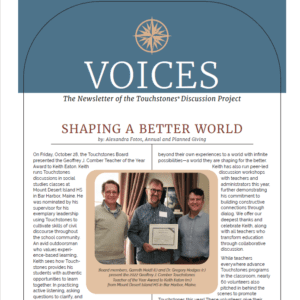By Howard Zeiderman
The role of the text for discussion in Touchstones programs is perhaps the Project’s most complicated and counter-intuitive feature. A touchstone originally meant a tool—a particular type of stone — that was used to evaluate the purity of gold. This name is appropriate for our work in education because we see texts as tools and not as they are more traditionally viewed: a source of information, knowledge, motivation, or wisdom. While most texts indeed convey those other elements, in Touchstones programs the text is intended to be used purposefully for a different set of outcomes. However, most Touchstones leaders are teachers. And teachers are typically trained to engage with texts as outlined above. Therefore, Touchstones texts can be easily misunderstood unless they are seen within the context of our programmatic goals and skill-building.
Many educators mistake the collections of Touchstones texts for anthologies that they can pick from or substitute for, as they wish. We often hear of English-Language Arts teachers who skip the math texts because they think no one will know how to discuss them or because they themselves are uncomfortable with them. That is precisely part of the reason for including them: to highlight and examine the structures in our culture that reinforce belief-systems that some people are legitimate speakers and some are not. Those structures must be challenged and dismantled.
Touchstones is a systematic program through which a group of participants becomes capable of genuine exploration that includes all participants. In this environment, leadership and responsibility for the group’s success are eventually shared. The Touchstones text serves as one of the tools for building inclusivity and collaboration. All Touchstones groups develop through four sequential stages: participation, cooperation, listening, and leadership. In each stage, the selected texts play essential, integral, and strategic roles. They are always coordinated with three elements:
• a group’s experience and history
• the dynamic process of discussion itself and group self-evaluation
• Touchstones’ overarching educational goals of fostering independent, confident, critical thinkers who employ diverse points of view in complex problem-solving
Unlike in an anthology, the positioning of the Touchstones text is not thematic, historical, or simply a matter of choice. The Touchstones lesson plan in which the text is embedded provides the instructional support to effectively empower students to explore their own thinking together and in relation to the text. This gradual development of a collaborative group takes time and requires consistent and deliberate focus. The cumulative results are indeed transformational and lasting, as each person learns to see her or his individual talents and how they can share these while gaining from others.




 Join the
Join the